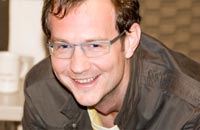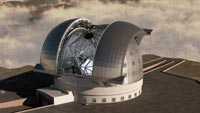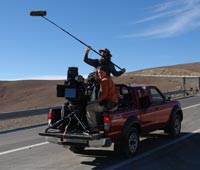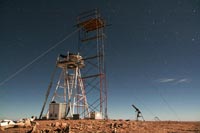An astronomer in a 3D world Inspire article
What do astronomy and film have in common? Both can involve Jochen Liske, astronomer and actor. Karin Ranero Celius takes us on a trip to the Paranal Observatory in Chile and tells us about Jochen’s latest film: Das Auge 3D.

Image courtesy of Dr Jochen
Liske
As darkness approaches, a glowing band of light, the Milky Way, extends from one horizon to the other, and stars shimmer over the site where a privileged few are investigating the beginning of the Universe: the Atacama Desert, in Chile.
A curiosity-driven astronomer from the European Southern Observatory (ESO)w1, Jochen Liske, has always had a passion for finding out how the world around us works, and has devoted his life to trying to uncover and explain its nature. “I’ve always been interested in science. I realised I had a passion for finding out what makes the world tick, when popular science magazines no longer satisfied my curiosity and always left me wanting more.”
Particularly drawn to the ‘fundamental’ sciences of particle physics and cosmology, Jochen pursued a career in physics, studying at the University of Bonn, Germany, and then gaining a PhD at the University of New South Wales, in Australia. “Astronomy is developing very rapidly, and it is very exciting and inspiring to watch it all happen, and to be a part of it in some small way. As an astronomer, I get to travel to very exotic and remote places, and I have the privilege of ‘playing’ with some pretty amazing equipment and analysing photons that have been zipping across the universe for a few billion years and suddenly crash into ‘my’ telescope.”

E-ELT
Image courtesy of Swinburne
Astronomy Productions / ESO
Jochen is currently working in the science team of the European Extremely Large Telescope (E-ELT)w2: “I use computer simulations to try and see how far we will get with this telescope in answering certain scientific questions.”
His main research goals, however, will be achieved only once the telescope is completed: “I want to use the E-ELT to observe, in real time, the evolution of the Universe, which occurs over billions of years, by watching it very closely over a time frame of only 20 years. I hope to be able to literally watch how the speed with which the Universe expands changes. This means that I need to make extremely precise measurements of the speed at which distant objects move away from Earth. A very large ground-based telescope is needed to perform these measurements, so this will only be possible with the E-ELT. This and other experiments carried out with the E-ELT could provide important clues to the nature of the, as yet, unexplained acceleration of the Universe’s expansion, leading to a more fundamental insight into the basic laws that govern nature.”
Starring in a 3D world

crew during filming
Image courtesy of Parallax
Raumprojektion
“Being an astronomer implies being a communicator: you end up talking a lot in front of audiences in conferences, schools, and public outreach events, so fear of public speaking is not something you frequently encounter among astronomers.” Jochen is not only an astronomer and a communicator, but also a talented actor. “I was always part of the theatre group in secondary school and performed in a number of plays. This has helped me in my job and to stand up in front of the camera.” His acting ability has been a key tool for communicating science in a world that is unthinkable without modern science.
As well as being ‘Dr J’, the host of two popular video podcasts, the Hubblecastw3 and the ESOcastw4, which bring the latest science from the Hubble Space Telescope and from ESO to a wide audience, Jochen has participated in various astronomy-related documentaries and frequently gives media interviews and public talks. His participation in the E-ELT project, however, has led to his most stellar appearance thus far: in Das Auge 3D (The Eye 3D)w5.
Once we don our 3D glasses, the movie theatre merges with the arid landscape, and we are virtually transported to Cerro Paranal, one of the most remote locations on the planet, and the site of one of the best observatories in the world, the Paranal Observatoryw6.

Image courtesy of ESO / HH Heyer
According to Nikolai Vialkowitsch, director of Das Auge 3D, “it is not a movie about science, it’s about curiosity, and how curiosity led to science, and science led to devices to explore the stars. It is the story of one of these devices: the Very Large Telescope (VLT), its people and the environment of the Paranal Observatory. It is the story of an age-old fascination.” Building and operating technological masterpieces such as the VLT requires many years of hard work, money and the efforts of countless individuals – without which the science could not be done.

one of the driest places on
Earth. The water supply is
regularly brought in big
tanks from Antofagasta, the
next city, which is one and a
half hours away by car
Image courtesy of ESO
We accompany Marcelo, a crucial person in the operation of Paranal, on his daily three-hour drive to supply the entire VLT complex with 27 000 litres of water. Without him, the observatory would not function.
Leaving the heat of the desert, we are then taken on a breathtaking tour of the site. One moment we are inside the giant domes, nearly touching the mirrors of the 8.2 m diameter telescopes.
Then we are outside on the telescope platform, where one of the Unit Telescopes moves towards us as it is positioned for its next observation. And then we suddenly find ourselves beneath the summit of Cerro Paranal, in the dark blue realm of the Very Large Telescope Interferometer (VLTI)w7 delay tunnel: the world of Nicolas Schuhler. He is an engineer who is living his schoolboy dream: to work on the VLTI.
Eventually, we are taken to a deserted area about 30 km from Paranal. Jochen climbs the small tower atop a bare mountain and looks into the desert.

the site of the VLT, looked
like Cerro Ventarrones does
today
Image courtesy of ESO / G
Lombardi
This is Cerro Ventarrones. It was one of the possible sites for the construction of the E-ELT before Cerro Armazones was finally chosen. Jochen tells us “It is just this rickety little five or six metre high tower with a small telescope and a meteorology station, so it’s all very rough and desert-like up there. It’s quite an achievement to build such high-tech structures like the VLT or the E-ELT out here.”
In Das Auge 3D, Nikolai and Jochen aim to bring astronomy closer to the public and inspire them to want to know more. Have you ever wondered what the world would be like if humans had not been curious and eager to answer questions? Jochen thinks that “we would still think that Earth is the centre of the Universe, we still wouldn’t know why apples fall from trees, and we’d be navigating by compass alone. Although astronomy won’t give us a cure for cancer and it won’t provide us with clean, free energy either, I strongly believe that it is worth doing. And communicating.”
Das Auge 3D: The next best thing to really being at Paranal
In June 2009, a crew of German 3D film experts from Parallax Raumprojektion travelled to Chile’s Atacama Desert, one of the most arid places on Earth, where ESO’s Very Large Telescope is located on Mount Paranal. Das Auge 3D is the first 3D documentary produced in Germany. Directed by Nikolai Vialkowitsch, the film, lasting about 45 minutes, transports the viewers to one of the world’s greatest observatories. The motion picture was appointed a special project of the International Year of Astronomyw8 and has won a special prize for its images at the 2010 Dimension3 film festivalw9 in Seine-Saint-Denis, France. Although not yet available on DVD, it is currently being shown in German in cinemas in Germany and Austria. The English version will be released soon. It has been bought by National Geographic and will soon be released worldwide.
Interested schools can contact Stefanie Knoll (email: distribution@raumprojektion.de) to book a German-language screening in collaboration with a 3D cinema nearby. It is also possible to invite the director or one of the astronomers from the film as interview partners. The film website offers a teaching unit on the telescopes, to better integrate the screening in the curriculum, as well as a physics teacher’s report on his experiences with watching the film in schoolw5.
Acknowledgement
The author would like to thank Parallax Raumprojektionfor their cooperation.
Web References
- w1 – ESO, the European Southern Observatory, is the foremost intergovernmental astronomy organisation in Europe, and the world’s most productive astronomical observatory. See: www.eso.org
- w2 – ESO’s E-ELT will be 42 m in diameter and will be the world’s biggest eye on the sky. For more information see: www.eso.org/public/teles-instr/e-elt.html
- w3 – Hubblecast is a scientific and educational videocast about the Hubble telescope, offered for download in several formats: standard (mov, mpeg, mp4, m4v), HD (High Definition) and Full HD. To watch Hubblecasts see: www.spacetelescope.org/videos/archive/category/hubblecast
- w4 – ESOcast is a videocast series dedicated to bringing you the latest news and research from ESO, available in the same formats as the Hubblecastw3 except for Full HD. To watch the episodes, see: www.eso.org/public/videos/archive/category/esocast
- w5 –For more information on Das Auge 3D (The eye 3D), where it is being screened, and material for schools, see: http://dasauge3d.wordpress.com
- w6 – Paranal is an ESO-operated astronomical observatory located on Cerro Paranal in Chile, at an altitude of 2635 m. It is home to the Very Large Telescope (VLT), the world’s most advanced visible-light astronomical observatory, which consists of four unit telescopes with main mirrors of 8.2-m diameter and four movable 1.8-m diameter auxiliary telescopes. For more information about Paranal visit the ESO websitew1. To learn more about the VLT, see:
- Pierce-Price D (2006) Running one of the world’s largest telescopes. Science in School 1: 56-60. www.scienceinschool.org/2006/issue1/telescope
- w7 – The Very Large Telescope Interferometer (VLTI) combines two or three of the VLT telescopes, allowing astronomers to see details up to 25 times finer than with the individual telescopes. To learn more about the VLT and interferometry, search the ESO website (www.eso.org) or use the direct links http://tinyurl.com/35we9qg and http://tinyurl.com/38ov7s4
- w8 – For a collection of education resources surrounding the International Year of Astronomy, see:
- Starr C, Harwood C (2009) Education resources for the International Year of Astronomy. Science in School 13. www.scienceinschool.org/2009/issue13/iya
- w9 – To find more information on the Dimension3 film festival, see: www.dimension3-expo.com/uk/festival.php





